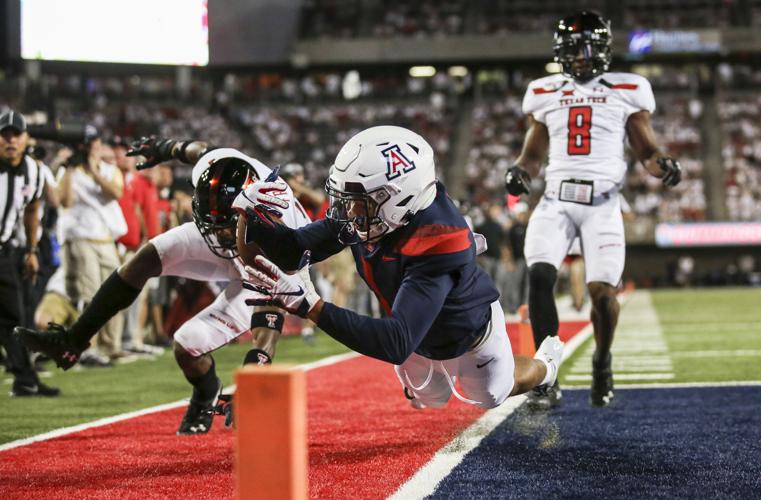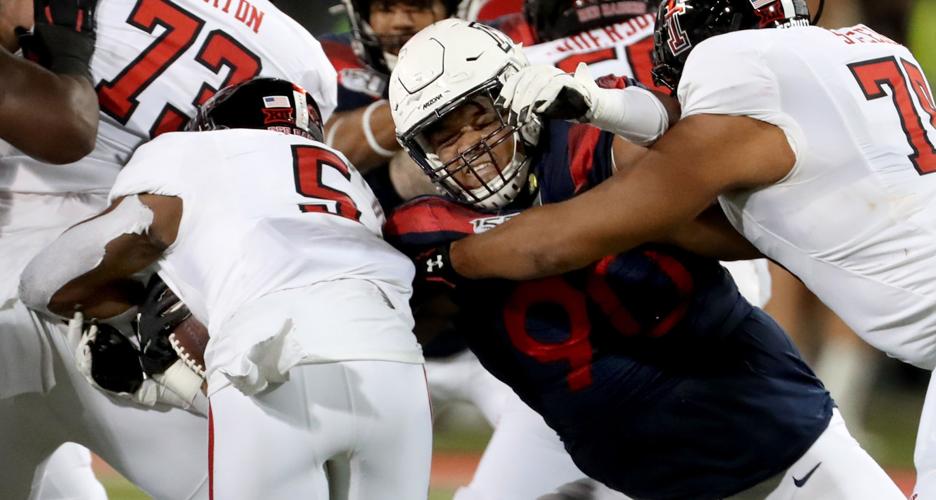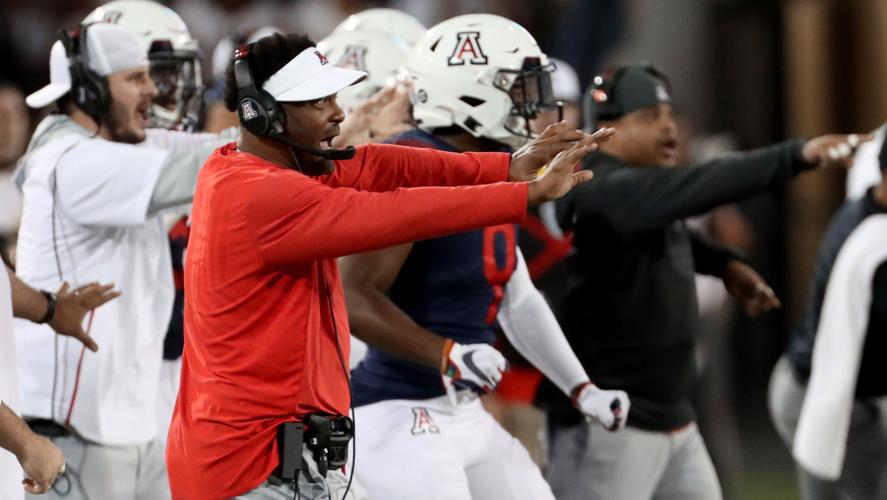Here are five storylines to watch as the Arizona Wildcats open Pac-12 play against UCLA Saturday night at Arizona Stadium:
DT Trevon Mason finally is making the grade for the Arizona Wildcats

Arizona defensive lineman Trevon Mason (90) fights through a block to fill the gap and bring down Texas Tech running back Armand Shyne (5) for a loss in the third quarter of their football game at Arizona Stadium, Tucson, Sept. 14, 2019.
Trevon Mason was supposed to become an Arizona Wildcat in January. The junior-college defensive tackle was supposed to be one of the UA’s midyear enrollees.
But Mason failed a statistics class at Navarro College. He couldn’t enroll at Arizona until he passed.
“I was worried,” Mason said this week amid preparations for Saturday’s Pac-12 opener against UCLA. “I was like, ‘Dang, am I gonna make it?’ ”
Mason had support from his mother, Ebony, and his aunt, Ida.
“You know you’ve gotta get this done,” they told him. “This is your dream.”
Mason passed the class on July 10. Two weeks later, he enrolled at the UA. The next day, the Wildcats reported for training camp.
Mason has come a long way since then. He has lost weight and gained a prominent spot in Arizona’s starting lineup.
Mason had a career-high three solo tackles, including his first stop for a loss, in the UA’s 28-14 victory over Texas Tech on Sept. 14. It was the first time Mason felt as if he was truly in game shape.
“I was still good in the fourth quarter,” the big, soft-spoken Texan said.
Mason is listed at 6 feet 5 inches. He weighed 315 pounds when he reported for camp. He checked in at 305 this week.
Mason and fellow 300-pound JC transfer Myles Tapusoa, who had two solo tackles two weeks ago against Texas Tech, have provided what Kevin Sumlin and his staff were seeking when Arizona signed them – with a certain degree of delayed gratification.
When discussing the pair during training camp, UA defensive line coach Iona Uiagalelei said: “They’re older guys. My expectation is for them to come in and play right away.”
Mason and Tapusoa did indeed play right away. But they weren’t as mobile or impactful against Hawaii or NAU as they were vs. Texas Tech.
Tapusoa arrived in January as planned, but he was so far from game shape that he had to sit out most of spring practice.
Mason didn’t get that early jump because of his academic situation. He worked out on his own while getting his schoolwork done. It took all of one team practice for Mason to realize “it wasn’t the same. It wasn’t the same at all.”
What was the first day like?
“I was tired,” Mason said, “Like, gassed.”
Sumlin wasn’t surprised that it took Arizona’s three new defensive tackles — Mason, Tapusoa (6-0, 325) and freshman Kyon Barrs (6-2, 299) — extra time to build their stamina. The staff remained patient with them, knowing replacements were needed for the departed PJ Johnson and Dereck Boles.
“They’re big men, and it’s hot out there,” Sumlin said. “They’ve been playing themselves into shape.”
Mason has the size to be a pro. When college coaches began visiting him at Sam Houston High School in Arlington, they told him as much. “You can be in the league one day,” Mason recalled them saying.
He didn’t have the grades to get into a four-year university.
Mason hadn’t taken school seriously up to that point. When he realized his football-playing dreams could crumble as a result, he changed his ways.
“I just woke up,” Mason said. “Like, let me get on my grind and do this.”
Mason knew he’d have to attend a junior college. He compiled 49 tackles and four sacks in two seasons at Navarro, which is located in Corsicana, about an hour south of Dallas. He picked Arizona in part because his former position coach, Chris Achuff, is now with the Cardinals.
When he finally got to the UA, Mason scarcely could believe his good fortune.
“I showed up, and they gave me some stuff,” he said, referring to the usual gear student-athletes receive. “I was like, ‘Can we keep this?’ They were like, ‘Yeah, sure.’ ”
Mason just might be a keeper too.
99-yard drive vs. Texas Tech showed Wildcats ‘can run the ball against anyone’

Gary Brightwell celebrates after diving into the end zone against Texas Tech. He is one of five scholarship tailbacks on UA’s roster.
More than a week later, they still wanted to talk about the 99-yard drive.
“It was awesome,” Arizona tight end Bryce Wolma said.
“It’s something special,” Wildcats running back Gary Brightwell added.
It wasn’t a run-of-the-mill 99-yard drive, if such a thing exists. It was a run-up-the-middle 99-yard drive.
All 13 UA plays were runs. The last one, by Brightwell from 1 yard out, put the finishing touch on the Wildcats’ 28-14 victory over Texas Tech.
“I thought we played pretty well on defense up until that drive,” Red Raiders coach Matt Wells said afterward. “And then, truth be told, they imposed their will on us.”
The hope inside the Lowell-Stevens Football Facility is that the 99-yard drive wasn’t a one-off – that it’s a sign of bigger and better things to come for the Arizona offense.
As Wildcats coach Kevin Sumlin put it: “To run it that many times for 99 yards to win a game … that should give us some confidence going into conference play.”
Wolma and Brightwell were brimming with confidence while discussing the drive and prepping for the Pac-12 opener against UCLA.
Wolma said the Wildcats could tell at a certain point that the Red Raiders were spent.
“Once we got to the 50-yard line, guys from Texas Tech were coming back with hands on their knees, hands on their hips,” Wolma said. “That kind of gave us a little edge.
“They weren’t talking at all. It was dead silence on the other side of the ball. That’s when we kind of knew we had them.”
Brightwell did the heaviest lifting on the drive, carrying the ball eight times for 39 hard-earned yards. He twice converted on third-and-1.
As a running back, he reveled in advancing the ball the length of the field without a single pass being called or thrown.
“All runs? That’s special to me,” Brightwell said. “It opened a lot of eyes in the Pac-12.
“Now we know we can run the ball against anyone.”
Veteran pass catchers accepting roles, which include ‘thankless’ work

Arizona wide receiver Cedric Peterson (18) gets wide open behind Texas Tech defensive back Zech McPhearson (8) to get the ball down inside the Red Raider five late in the third quarter of their football game at Arizona Stadium, Tucson, Sept. 14, 2019.
A true go-to receiver has yet to emerge for Arizona, and that might remain the case for the remainder of the season.
Two potential candidates for that role entering the campaign – senior wideout Cedric Peterson and junior tight end Bryce Wolma — haven’t been huge factors in the passing game. But both said they’re all right with that as long as the Wildcats are winning.
“At the end of the day, it’s not about my individual success. It’s about the team,” Peterson said. “I’m happy to see all the other receivers around me get touches too.”
“I obviously hope to get some more,” Wolma said. “But I’m never going to complain about it. Whatever I can do to be on the field and help the team win, that’s what I’m going to do.”
Peterson has five receptions in three games. Wolma has one in two appearances; he missed the NAU game because of a sprained ankle. Team leader Tayvian Cunningham has 12.
UA coach Kevin Sumlin said Peterson has been “solid” this season. Peterson said he has played “OK.”
Projected to be Arizona’s leading receiver after playing a supporting role in past seasons, Peterson got shut out in the opener at Hawaii. He had four catches vs. NAU, but they netted only 16 yards. His biggest play of the season came against Texas Tech — a 47-yard grab in the third quarter that set up a UA touchdown.
“It’s all about winning,” Peterson said. “As long as I’m doing my part – whether I’m getting the ball or not, blocking or whatever.”
Wolma has contributed substantially as a blocker. Sumlin described him as an “unsung hero” in Arizona’s run game, which again paces the Pac-12. Wolma said he has made his “biggest jump” as a blocker.
“I think I was a little soft my freshman year and a little bit of last year,” Wolma said. “I kind of took it upon myself this offseason to get a little more … fight to me down in the trenches.”
Wolma’s wish to be a bigger part of the passing game hasn’t come to fruition. He caught only five passes last year after snagging 28 as a freshman under the previous coaching staff.
But Wolma can take pride in helping the Wildcats average 307.7 rushing yards per game.
“It’s a thankless job,” he said. “But I love to do it.”
Roster management is always on UA coach Kevin Sumlin’s agenda

Arizona head coach Kevin Sumlin and his bench try to get their message across to the defense during a drive by Texas Tech in the first quarter of their football game at Arizona Stadium, Tucson, Sept. 14, 2019.
But like every other week, roster management is just a notch or two down on Sumlin’s to-do list.
The redshirt rule implemented last season has made that task a little more demanding. Previously, if a freshman participated in just one game, he’d lose a year of eligibility. It wasn’t difficult to track.
Now, any player who hasn’t previously redshirted can participate in up to four games without losing a year. The Wildcats are about to play their fourth game of 2019. Decisions must be made soon whether to keep using freshmen such as tailback Michael Wiley or put them on the shelf to preserve their redshirt years.
Wiley is one of five freshmen who have appeared in each of Arizona’s first three games. The others are cornerbacks Christian Roland-Wallace and Bobby Wolfe, offensive lineman Jordan Morgan and linebacker Derrion Clark. Several other freshmen have played in two games.
“We started that conversation last week,” Sumlin said. “That conversation will really be had this week and then the beginning of next week.”
One factor Sumlin and his staff must consider is that Arizona currently has only 71 active scholarship players. The UA did not take full classes in either of the past two recruiting cycles, and several players transferred or were dismissed from the team this past offseason.
“We’d like to have more guys,” Sumlin said. “But we need to have the right guys. Just to have guys doesn’t really help you.”
Sumlin was hired on Jan. 14, 2018. By that point, Arizona had announced the addition of 16 players who were part of the first early signing day in December. He had about three weeks until the second signing date and decided the best long-term move was to keep some spots open. The Wildcats ended up signing 20 players, five shy of the annual maximum.
Sumlin this week explained the thought process behind that decision:
“Do we just run around looking for guys to fill the roster? Or do we take that next year and really evaluate what we need?
“That’s a process, evaluating your roster and then recruiting to your roster and your philosophy and your needs. That’s where we are right now. That’s why the evaluation process is the way it is. That’s where we were all out recruiting this (past) weekend.”
Should second-year jumps be expected from Kevin Sumlin, Chip Kelly?

Arizona head coach Kevin Sumlin, left, talks with UCLA head coach Chip Kelly prior to an NCAA college football game Saturday, Oct. 20, 2018, in Pasadena, Calif.
Arizona’s Kevin Sumlin and UCLA’s Chip Kelly are both in the early stages of their second seasons. Both programs were expected to take a leap in Year 2 – which is something that supposedly happens in college football.
Is the second-year jump a real thing, though? It’s too early to say with Sumlin and Kelly. A look at the early years for the past five coaches at each school suggests it might be more myth than reality:
ARIZONA
Rich Rodriguez
2012: 8-5 | 2013: 8-5
Mike Stoops
2004: 3-8 | 2005: 3-8
John Mackovic
2001: 5-6 | 2002: 4-8
Dick Tomey
1987: 4-4-3 | 1988: 7-4
Larry Smith
1980: 5-6 | 1981: 6-5
UCLA
Jim Mora
2012: 9-5 | 2013: 10-3
Rick Neuheisel
2008: 4-8 | 2009: 7-6
Karl Dorrell
2003: 6-7 | 2004: 6-6
Bob Toledo
1996: 5-6 | 1997: 10-2
Terry Donahue
1976: 9-2-1 | 1977: 7-4










